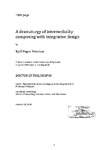A dramaturgy of intermediality: composing with integrative design
| dc.contributor.author | Petersen, Kjell Yngve | |
| dc.contributor.other | Faculty of Science and Engineering | en_US |
| dc.date.accessioned | 2013-10-31T12:39:01Z | |
| dc.date.available | 2013-10-31T12:39:01Z | |
| dc.date.issued | 2009 | |
| dc.identifier | NOT AVAILABLE | en_US |
| dc.identifier.uri | http://hdl.handle.net/10026.1/2506 | |
| dc.description.abstract |
The thesis investigates and develops a compositional system on intermediality in theatre and performance as a dramaturgical practice through integrative design. The position of the visual/sonic media in theatre and performance has been altered by the digitalisation and networking of media technologies, which enables enhanced dynamic variables in the intermedial processes. The emergent intermediality sites are made accessible by developments in media technologies and form part of broader changes towards a mediatised society: a simultaneous shift in cultural contexts, theatre practice and audience perception. The practice-led research is situated within a postdramatic context and develops a system of compositional perspectives and procedures to enhance the knowledge of a dramaturgy on intermediality. The intermediality forms seem to re-situate the actual/virtual relations in theatre and re-construct the processes of theatricalisation in the composition of the stage narrative. The integration of media and performers produces a compositional environment of semiosis, where the theatre becomes a site of narration, and the designed integration in-between medialities emerges as intermediality sites in the performance event. A selection of performances and theatre directors is identified, who each in distinct ways integrate mediating technologies as a core element in their compositional design. These directors and performances constitute a source of reflection on compositional strategies from the perspective of practice, and enable comparative discussions on dramaturgical design and the consistency of intermediality sites. The practice-led research realised a series of prototyping processes situated in performance laboratories in 2004-5. The laboratories staged investigations into the relation between integrative design procedures and parameters for composition of intermediality sites, particularly the relative presence in-between the actual and the virtual, and the relative duration and distance in-between timeness and placeness. The integration of performer activities and media operations into dramaturgical structures were developed as a design process of identifying the mapping and experiencing the landscape through iterative prototyping. The developed compositional concepts and strategies were realised in the prototype performance Still I Know Who I Am, performed October 2006. This final research performance was a full-scale professional production, which explored the developed dramaturgical designs through creative practice. The performance was realised as a public event, and composed of a series of scenes, each presenting a specific composite of the developed integrative design strategies, and generating a particular intermediality site. The research processes in the performance laboratories and the prototype performance developed on characteristics, parameters and procedures of compositional strategies, investigating the viability of a dramaturgy of intermediality through integrative design. The practice undertaken constitutes raw material from which the concepts are drawn and underpins the premises for the theoretical reflections. | en_US |
| dc.language.iso | en | en_US |
| dc.publisher | University of Plymouth | en_US |
| dc.title | A dramaturgy of intermediality: composing with integrative design | en_US |
| dc.type | Thesis | |
| plymouth.version | Full version: final and full version as approved by the examiners at the time of the award of your degree | en_US |
| dc.identifier.doi | http://dx.doi.org/10.24382/4283 |
Files in this item
This item appears in the following Collection(s)
-
01 Research Theses Main Collection
Research Theses Main


